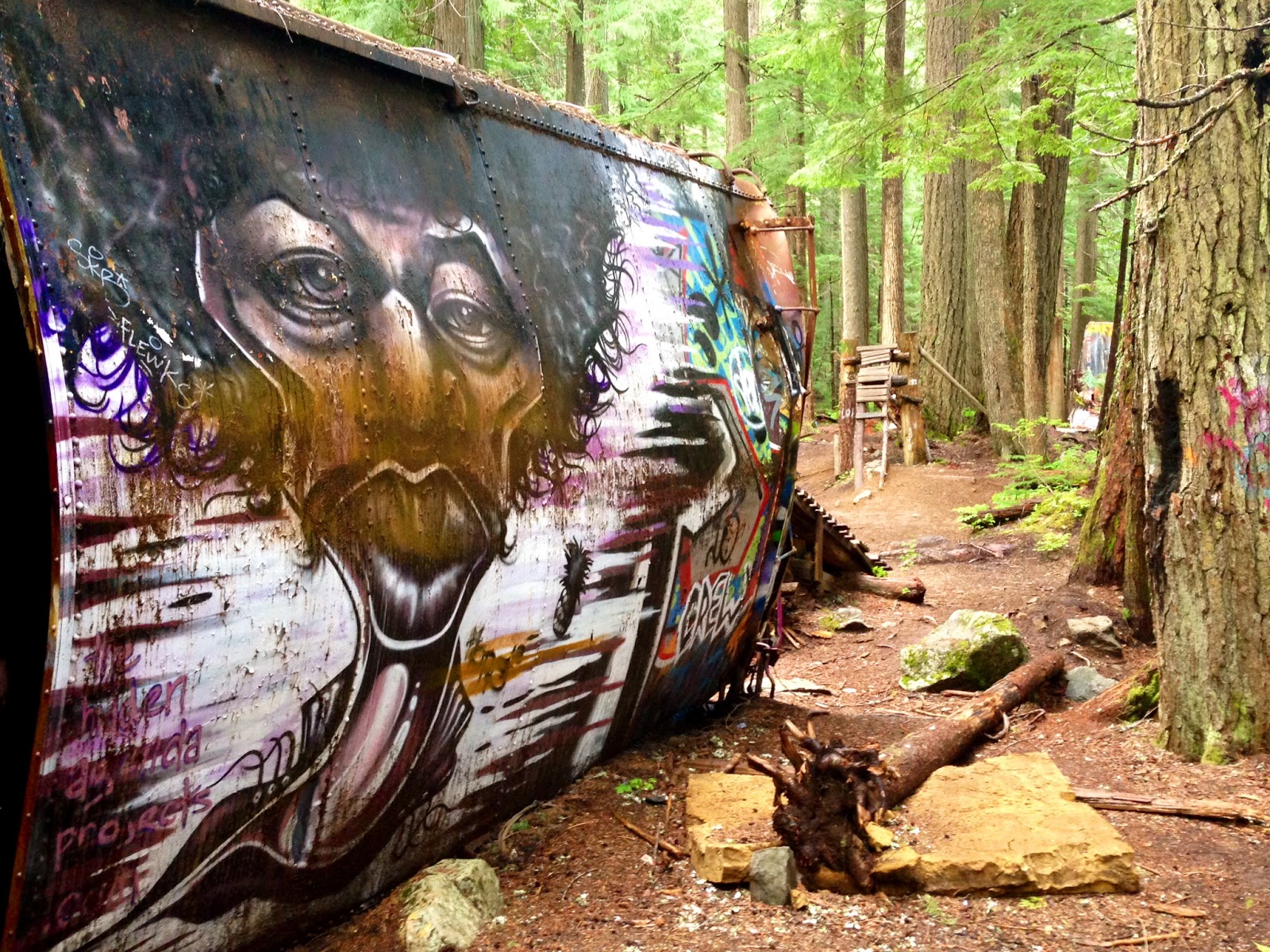Seeing as I travel quite a bit, I learned early on to stay away from mainstream tourist attractions and I most definitely don’t do anything organized unless it’s a rad festival. I love art, untouched discoveries and can’t get enough of Mother Nature. So when I first heard about the Whistler train wrecks, I will admit, it sounded too good to be true. Are you telling me that several train carts were actually left on an embankment of the Cheakamus River, and… they are now covered in beautiful local graffiti? It’s like a dream come true. My curiousity (and hope) got the better of me. So when I traveled to Whistler for the first time last August, I made it a point to find this ‘beautiful work of art’ even if it killed me. Thankfully, all it took was buying a pint of beer for my local friend in return for his guiding skills – wow, that was easy.
Unfortunately, like all West-coast weather, it was pouring rain the first time I went. But I was so excited, I didn’t even notice. With a mass of wet hair, I battled branches, slippery paths and even tempted my fate by walking along active railway tracks. Nothing was going to stop me. In fact, I was a little thankful it was raining, as a steady stream of water dripped from my rain jacket into my hiking shoes – it kept the bugs down, and most importantly, everything was glowing with colour. Green moss covered logs were stunning. The river was a crystal clear, Tiffany blue. The trees were ominously dark, which made the graffiti pop with vividness. I couldn’t believe my eyes. Call me crazy, maybe it was the colour, or maybe it was the fact that I had been staring at the ground the entire way there, as not to let another slippery rock get the better of me, but it was a magnificent sight of twisted metal among a growing forest. There are several carts scattered among the site. Yet, it doesn’t look like chaos, in fact, it’s rather peaceful. As you walk through the site, which is spread out given the fact that it is a real crash site, you can hear the Cheakamus river running (or rushing, depending on the time of year you visit) and the trees are not disrupted in the slightest. It’s amazing seeing how nature has adopted these carts as one of their own, growing into them and molding around them. The graffiti, if you can even call it that, is beautiful artwork. It restores my faith in humanity as individuals have truly taken the time to make something worth seeing, and not just tagging the crap out of it.
What’s even more eerie, is the fact that you can climb in, on top of and explore this once horrific disaster. Some brave soles even built an impressive bike ramp using the carts as jumps, which is now in poor condition, but worth a check out. And if you’re starting to think these carts were placed here strategically, take a look at some of the rock surfaces near a few of the box carts - you can see scratch marks.
Searching for information on the wreck, which supposedly happened around the 1950’s, is nearly impossible. But if you ask the locals, they’ll all tell you the same. “After the trains derailed,” which wasn’t uncommon for the Sea to Sky Corridor back then, “ It was deemed too expensive for them to clean up the mess,” therefore, leaving the carts as they were to rest next to the Cheakamus river, just south of Whistler.
The trail itself is a little hidden, but thanks to its slowly growing recognition there are now a few small markers, which guide you to its hidden location. I say ‘slowly growing reputation’ with a loving heart because, well… we all know what happens to a hidden gem once tourism marketing gets a hold of it – and I can say this honestly given my career. Say goodbye to the untouched surroundings I pine after so deeply. As it sits now, there are already bits of garbage creeping up, and random fire pits next to flattened tenting grounds.
How to get there

Park in Function Junction, behind the Olive Market and enter the trail-head here.
Follow it under the bridge (where highway 99 runs over top) and to the railway. Please remember, this is an active railway, so use extreme caution.
Shortly after reaching the rail bed, you duck in to the left (look for the yellow arrows that say ‘Train Wreck’ on them throughout the entire hike).
The main trail winds along the Cheakamus river, which is glacier fed.
You will hop back out onto the rail bed a few times throughout your walk (technically you could follow it most of the way, but it’s not as beautiful, or as safe).
Eventually the trail leads you straight to the train wreck.
Overall the walk from the road is roughly 25mins, at 1.5kms. Most class this as an easy hike, with little elevation, and it is. Just be leery of slippery rocks and roots if you are heading out after a rainfall.
Can’t find it? Ask a local, or me. I am always looking for an excuse to go out there.









No comments:
Post a Comment